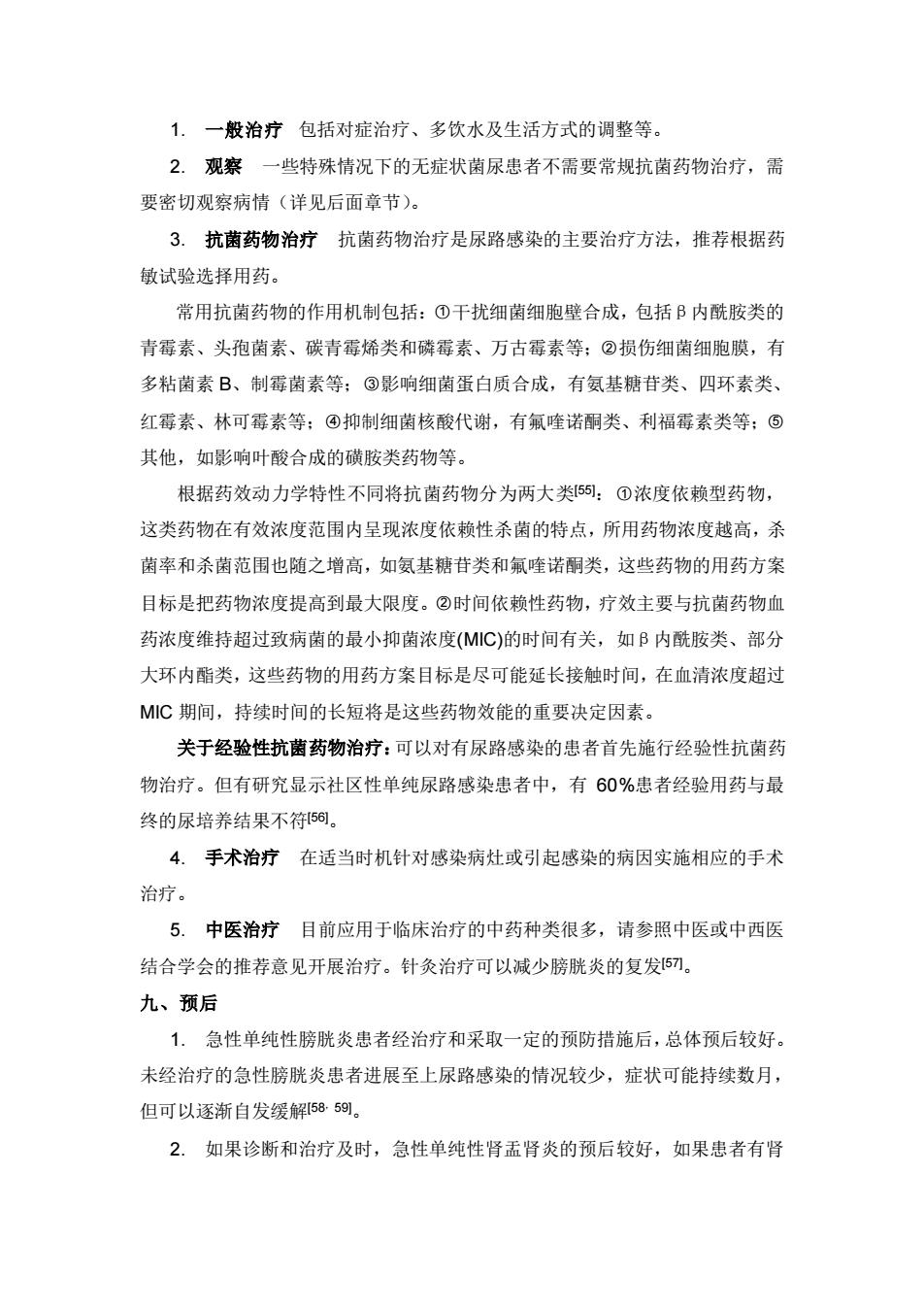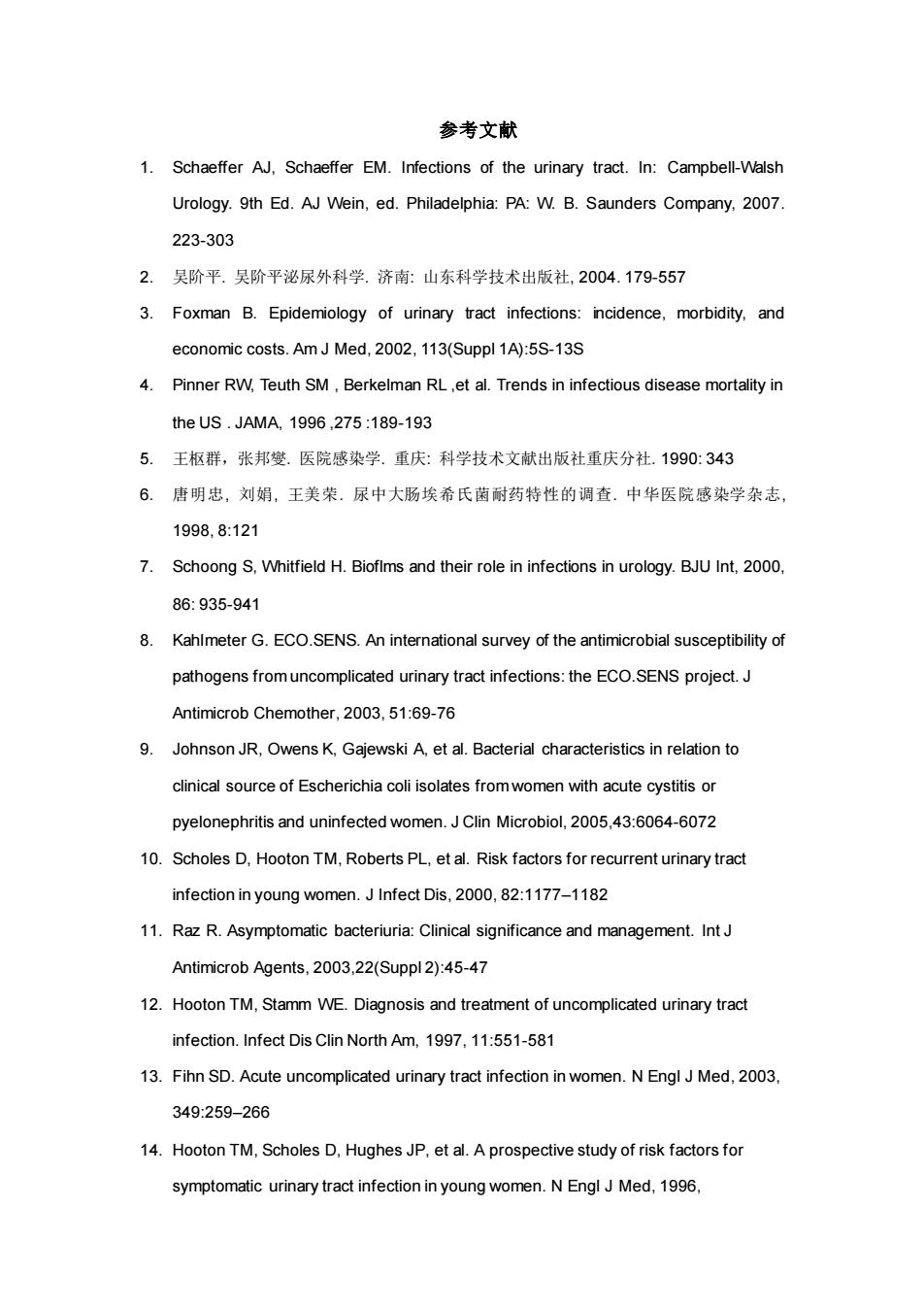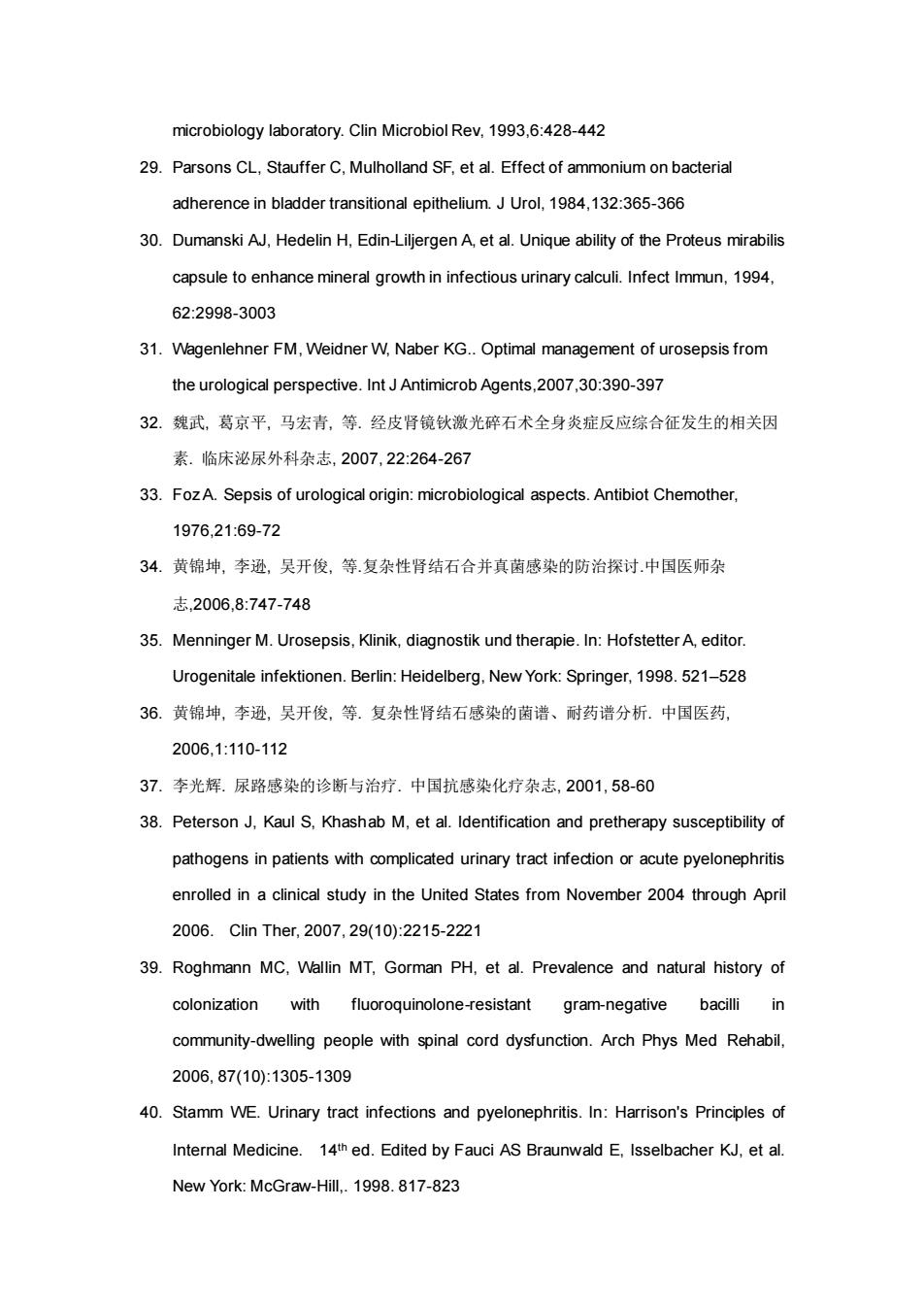
1.一般治疗包括对症治疗、多饮水及生活方式的调整等。 2.观察一些特殊情况下的无症状菌尿患者不需要常规抗菌药物治疗,需 要密切观察病情(详见后面章节)。 3.抗菌药物治疗抗菌药物治疗是尿路感染的主要治疗方法,推荐根据药 敏试验选择用药。 常用抗菌药物的作用机制包括:①干扰细菌细胞壁合成,包括B内酰胺类的 青霉素、头孢菌素、碳青香烯类和磷毒素、万古霉素等:②损伤细菌细胞膜,有 多粘菌素B、制霉菌素等:③影响细菌蛋白质合成,有氨基糖苷类、四环素类、 红霉素、林可霉素等:④抑制细菌核酸代谢,有氟喹诺酮类、利福霉素类等:⑤ 其他,如影响叶酸合成的磺胺类药物等。 根据药效动力学特性不同将抗菌药物分为两大类5阿:①浓度依赖型药物, 这类药物在有效浓度范围内呈现浓度依赖性杀菌的特点,所用药物浓度越高,杀 菌率和杀菌范围也随之增高,如氨基糖苷类和氟喹诺酮类,这些药物的用药方案 目标是把药物浓度提高到最大限度。②时间依赖性药物,疗效主要与抗菌药物血 药浓度维持超过致病菌的最小抑菌浓度(MC)的时间有关,如B内酰胺类、部分 大环内酯类,这些药物的用药方案目标是尽可能延长接触时间,在血清浓度超过 MC期间,持续时间的长短将是这些药物效能的重要决定因素。 关于经验性抗菌药物治疗:可以对有尿路感染的患者首先施行经验性抗菌药 物治疗。但有研究显示社区性单纯尿路感染患者中,有60%患者经验用药与最 终的尿培养结果不符1。 4.手术治疗在适当时机针对感染病灶或引起感染的病因实施相应的手术 治疗。 5.中医治疗目前应用于临床治疗的中药种类很多,请参照中医或中西医 结合学会的推荐意见开展治疗。针灸治疗可以减少膀胱炎的复发57。 九、预后 1.急性单纯性膀胱炎患者经治疗和采取一定的预防措施后,总体预后较好。 未经治疗的急性膀胱炎患者进展至上尿路感染的情况较少,症状可能持续数月, 但可以逐渐自发缓解5859。 2.如果诊断和治疗及时,急性单纯性肾盂肾炎的预后较好,如果患者有肾
1. 一般治疗 包括对症治疗、多饮水及生活方式的调整等。 2. 观察 一些特殊情况下的无症状菌尿患者不需要常规抗菌药物治疗,需 要密切观察病情(详见后面章节)。 3. 抗菌药物治疗 抗菌药物治疗是尿路感染的主要治疗方法,推荐根据药 敏试验选择用药。 常用抗菌药物的作用机制包括:○1 干扰细菌细胞壁合成,包括β内酰胺类的 青霉素、头孢菌素、碳青霉烯类和磷霉素、万古霉素等;○2 损伤细菌细胞膜,有 多粘菌素 B、制霉菌素等;○3 影响细菌蛋白质合成,有氨基糖苷类、四环素类、 红霉素、林可霉素等;○4 抑制细菌核酸代谢,有氟喹诺酮类、利福霉素类等;○5 其他,如影响叶酸合成的磺胺类药物等。 根据药效动力学特性不同将抗菌药物分为两大类[55]:○1 浓度依赖型药物, 这类药物在有效浓度范围内呈现浓度依赖性杀菌的特点,所用药物浓度越高,杀 菌率和杀菌范围也随之增高,如氨基糖苷类和氟喹诺酮类,这些药物的用药方案 目标是把药物浓度提高到最大限度。○2 时间依赖性药物,疗效主要与抗菌药物血 药浓度维持超过致病菌的最小抑菌浓度(MIC)的时间有关,如β内酰胺类、部分 大环内酯类,这些药物的用药方案目标是尽可能延长接触时间,在血清浓度超过 MIC 期间,持续时间的长短将是这些药物效能的重要决定因素。 关于经验性抗菌药物治疗:可以对有尿路感染的患者首先施行经验性抗菌药 物治疗。但有研究显示社区性单纯尿路感染患者中,有 60%患者经验用药与最 终的尿培养结果不符[56]。 4. 手术治疗 在适当时机针对感染病灶或引起感染的病因实施相应的手术 治疗。 5. 中医治疗 目前应用于临床治疗的中药种类很多,请参照中医或中西医 结合学会的推荐意见开展治疗。针灸治疗可以减少膀胱炎的复发[57]。 九、预后 1. 急性单纯性膀胱炎患者经治疗和采取一定的预防措施后,总体预后较好。 未经治疗的急性膀胱炎患者进展至上尿路感染的情况较少,症状可能持续数月, 但可以逐渐自发缓解[58,59]。 2. 如果诊断和治疗及时,急性单纯性肾盂肾炎的预后较好,如果患者有肾

脏其他病变、糖尿病或应用免疫抑制等情况,血行感染和死亡的发生率升高,但 临床上缺乏此类患者的长期随访数据60。 3.如果存在严重的上尿路病变(畸形、狭窄或返流等),患者出现炎症复发 和肾功能不全的可能性明显增加
脏其他病变、糖尿病或应用免疫抑制等情况,血行感染和死亡的发生率升高,但 临床上缺乏此类患者的长期随访数据[60]。 3. 如果存在严重的上尿路病变(畸形、狭窄或返流等),患者出现炎症复发 和肾功能不全的可能性明显增加

参考文献 1.Schaeffer AJ,Schaeffer EM.Infections of the urinary tract.In:Campbell-Walsh Urology.9th Ed.AJ Wein,ed.Philadelphia:PA:W.B.Saunders Company,2007. 223-303 2.吴阶平.吴阶平泌尿外科学.济南:山东科学技术出版社,2004.179-557 3.Foxman B.Epidemiology of urinary tract infections:incidence.morbidity,and economic costs.AmJ Med.2002,113(Suppl1A):5S-13S 4.Pinner RW.Teuth SM,Berkelman RL,et al.Trends in infectious disease mortality in the US.JAMA,1996,275:189-193 5.王枢群,张邦燮.医院感染学.重庆:科学技术文献出版社重庆分社.1990:343 6.唐明忠,刘娟,王美荣,尿中大肠埃希氏菌耐药特性的调查.中华医院感染学杂志 1998,8:121 7.Schoong S.Whitfield H.Bioflms and their role in infections in urology.BJU Int,2000, 86:935-941 8.Kahlmeter G.ECO.SENS.An international survey of the antimicrobial susceptibility of pathogens fromuncomplicated urinary tract infections:the ECO.SENS project.J Antimicrob Chemother.2003.51:69-76 9.JohnsonJR,Owens K.Gajewski A,et al.Bacterial characteristics in relation to clinica source of Escherichia coli isolates fromwomen with acute cystitis or pyelonephritis and uninfected women.JClin Microbiol,200,43:6064-6072 10.Scholes D.Hooton TM.Roberts PL.et al.Risk factors for recurrent urinary tract infection in young women.JInfect Dis,2000,82:1177-1182 11.Raz R.Asymptomatic bacteriuria:Clinical significance and management.IntJ Antimicrob Agents,2003,22(Suppl2):45-47 12.Hooton TM.Stamm WE.Diagnosis and treatment of uncomplicated urinary tract infection.Infect Dis Clin North Am,1997,11:551-581 13.Fihn SD.Acute uncomplicated urinary tract infection in women.N Engl J Med,2003. 349:259-266 14.Hooton TM.Scholes D.Hughes JP.et al.A prospective study of risk factors for symptomatic urinary tract infection in young women.N Engl J Med,1996
参考文献 1. Schaeffer AJ, Schaeffer EM. Infections of the urinary tract. In: Campbell-Walsh Urology. 9th Ed. AJ Wein, ed. Philadelphia: PA: W. B. Saunders Company, 2007. 223-303 2. 吴阶平. 吴阶平泌尿外科学. 济南: 山东科学技术出版社, 2004. 179-557 3. Foxman B. Epidemiology of urinary tract infections: incidence, morbidity, and economic costs. Am J Med, 2002, 113(Suppl 1A):5S-13S 4. Pinner RW, Teuth SM , Berkelman RL ,et al. Trends in infectious disease mortality in the US . JAMA, 1996 ,275 :189-193 5. 王枢群,张邦燮. 医院感染学. 重庆: 科学技术文献出版社重庆分社. 1990: 343 6. 唐明忠, 刘娟, 王美荣. 尿中大肠埃希氏菌耐药特性的调查. 中华医院感染学杂志, 1998, 8:121 7. Schoong S, Whitfield H. Bioflms and their role in infections in urology. BJU Int, 2000, 86: 935-941 8. Kahlmeter G. ECO.SENS. An international survey of the antimicrobial susceptibility of pathogens from uncomplicated urinary tract infections: the ECO.SENS project. J Antimicrob Chemother, 2003, 51:69-76 9. Johnson JR, Owens K, Gajewski A, et al. Bacterial characteristics in relation to clinical source of Escherichia coli isolates from women with acute cystitis or pyelonephritis and uninfected women. J Clin Microbiol, 2005,43:6064-6072 10. Scholes D, Hooton TM, Roberts PL, et al. Risk factors for recurrent urinary tract infection in young women. J Infect Dis, 2000, 82:1177–1182 11. Raz R. Asymptomatic bacteriuria: Clinical significance and management. Int J Antimicrob Agents, 2003,22(Suppl 2):45-47 12. Hooton TM, Stamm WE. Diagnosis and treatment of uncomplicated urinary tract infection. Infect Dis Clin North Am, 1997, 11:551-581 13. Fihn SD. Acute uncomplicated urinary tract infection in women. N Engl J Med, 2003, 349:259–266 14. Hooton TM, Scholes D, Hughes JP, et al. A prospective study of risk factors for symptomatic urinary tract infection in young women. N Engl J Med, 1996

335468-474 15.Gupta K.Hillier SL,Hooton TM,et al.Effects of contraceptive method on the vaginal microbial flora:a prospective evaluation.J Infect Dis,2000.181:595-601 16.Dwyer PL.Reilly M.Recurrent urinary tract infection in the female.Curt Op in Obste Gynecol,.2002,14(⑤):537-543 17.Raz R,Stamm WE.A controlled trial of intravaginal estriol in postmenopausal women with recurrent urinary tract infections.NEnglJ Med,1993.329:753-756 18.Nicolle LE.Uncomplicated urinary tract infection in adults including uncomplicated pyelonephritis.Urol Clin North Am,2008,35(1):1-12 19.Hu KK.Boyko EJ,Scholes D.et al.Risk factors for urinary tract infections in postmenopausal women.Arch Intern Med,2004.164:989-993 20.Foxman B.Somsel P,Tallman P,et al.Urinary tract infection among women aged 40 to 65:behavioral and sexual risk factors.J Clin Epidemiol.2001.54:710-718 21.Frankenschmidt A.Naber KG,Bischoff W.et al.Once-daily fleroxacin versus twice-daily ciprofloxacin in the treatment of complicated urinary tract infections.J Urol 1997,158:1494-1499 22.许彩青.杨萍.复杂性尿路感染的致病菌分布及其耐药性分析.新医学,2005,36:91-92 23.Nicolle LE.Apractical guide to the management of complicated urinary tract infedion Dug5,1997,53:583-592 24.Cox CE,Holloway WJ,Geckler RW.A multicenter comparative study of meropenem and imipenemcilastatin in the treatment of complicated urinary tract infections in hospitalized patients.Clin Infect Dis,1995,21:86-92 25.Reid G.Biofilms in infectious disease and on medical devices.Int JAntimicrob Agents,1999.11:223-226 26.Naber KG.Bishop MC.Bjerklund-Johansen TE,et al.Guidelines on the management of urinary and male genital tract infections.EuropeanAssociation of Urology,2006 7-68 27.DobardzicAM,Dobardzic R.Epidemiological features of complicated UTI in a district hospital of Kuwait.Eur J Epidemiol,1997.13:465-470 28.Emori TG.Gaynes RP.An overview of nosocomial infections,including the role of the
335:468-474 15. Gupta K, Hillier SL, Hooton TM, et al. Effects of contraceptive method on the vaginal microbial flora: a prospective evaluation. J Infect Dis, 2000, 181: 595-601 16. Dwyer PL, Reilly M. Recurrent urinary tract infection in the female. Curt Op in Obstet Gynecol, 2002, 14 (5): 537-543 17. Raz R, Stamm WE. A controlled trial of intravaginal estriol in postmenopausal women with recurrent urinary tract infections. N Engl J Med, 1993, 329:753-756 18. Nicolle LE. Uncomplicated urinary tract infection in adults including uncomplicated pyelonephritis. Urol Clin North Am, 2008, 35(1):1-12 19. Hu KK, Boyko EJ, Scholes D, et al. Risk factors for urinary tract infections in postmenopausal women. Arch Intern Med, 2004,164:989-993 20. Foxman B, Somsel P, Tallman P, et al. Urinary tract infection among women aged 40 to 65: behavioral and sexual risk factors. J Clin Epidemiol, 2001, 54:710-718 21. Frankenschmidt A, Naber KG, Bischoff W, et al. Once-daily fleroxacin versus twice-daily ciprofloxacin in the treatment of complicated urinary tract infections. J Urol, 1997,158:1494-1499 22. 许彩青,杨萍.复杂性尿路感染的致病菌分布及其耐药性分析. 新医学, 2005, 36:91-92 23. Nicolle LE. A practical guide to the management of complicated urinary tract infection. Drugs, 1997,53:583-592 24. Cox CE, Holloway WJ, Geckler RW. A multicenter comparative study of meropenem and imipenem/cilastatin in the treatment of complicated urinary tract infections in hospitalized patients. Clin Infect Dis, 1995,21:86-92 25. Reid G. Biofilms in infectious disease and on medical devices. Int J Antimicrob Agents, 1999,11:223-226 26. Naber KG, Bishop MC, Bjerklund-Johansen TE, et al. Guidelines on the management of urinary and male genital tract infections. European Association of Urology, 2006. 7-68 27. Dobardzic AM, Dobardzic R. Epidemiological features of complicated UTI in a district hospital of Kuwait. Eur J Epidemiol, 1997,13:465-470 28. Emori TG, Gaynes RP. An overview of nosocomial infections, including the role of the

microbiology laboratory.Clin Microbiol Rev.1993.6:428-442 29.Parsons CL,Stauffer C,Mulholland SF,et al.Effect of ammonium on bacterial adherence in bladder transitional epithelium.J Urol,1984,132:365-366 30.DumanskiAJ.Hedelin H.Edin-LiljergenA.et al.Unique ability of the Proteus mirabilis capsule to enhance mineral growth in infectious urinary calculi.Infect Immun,1994. 62:2998-3003 31.Wagenlehner FM.Weidner W.Naber KG..Optimal management of urosepsis from the urological perspective.Int JAntimicrobAgents,2007,30:390-397 32.魏武,葛京平,马宏青,等.经皮肾镜钬激光碎石术全身炎症反应综合征发生的相关因 素.临床泌尿外科杂志,2007,22:264-267 33.FozA.Sepsis of urological origin:microbiological aspects.Antibiot Chemother 1976,21:69-72 34.黄锦坤,李逊,吴开俊,等复杂性肾结石合并其菌感染的防治探讨.中国医师杂 志,2006,8:747-748 35.Menninger M.Urosepsis,Klinik,diagnostik und therapie.In:HofstetterAeditor. Urogenitale infektionen.Berlin:Heidelberg.New York:Springer,1998.521-528 36.黄锦坤,李逊,吴开俊,等。复杂性肾结石感染的南谱、耐药谱分析。中国医药, 2006,1:110-112 37.李光辉。尿路感染的诊断与治疗.中国抗感染化疗杂志,2001,58-60 38.Peterson J.Kaul S.Khashab M.et al.Identification and pretherapy susceptibility of pathogens in patients with complicated urinary tract pyeonepritis enrolled in a clinical study in the United States from November 2004 through Apri 2006.Clin Ther,2007,29(10):2215-2221 39.Roghmann MC,Wallin MT,Gorman PH.et al.Prevalence and natural history of colonization with fluoroquinolone-resistant gram-negative bacilli in community-dwelling people with spinal cord dysfunction.Arch Phys Med Rehabil, 2006,87(10):1305-1309 40.Stamm WE.Urinary tract infections and pyelonephritis.In:Harrison's Principles of Internal Medicine.14h ed.Edited by Fauci AS Braunwald E,Isselbacher KJ.et al. New York:McGraw-Hill.1998.817-823
microbiology laboratory. Clin Microbiol Rev, 1993,6:428-442 29. Parsons CL, Stauffer C, Mulholland SF, et al. Effect of ammonium on bacterial adherence in bladder transitional epithelium. J Urol, 1984,132:365-366 30. Dumanski AJ, Hedelin H, Edin-Liljergen A, et al. Unique ability of the Proteus mirabilis capsule to enhance mineral growth in infectious urinary calculi. Infect Immun, 1994, 62:2998-3003 31. Wagenlehner FM, Weidner W, Naber KG.. Optimal management of urosepsis from the urological perspective. Int J Antimicrob Agents,2007,30:390-397 32. 魏武, 葛京平, 马宏青, 等. 经皮肾镜钬激光碎石术全身炎症反应综合征发生的相关因 素. 临床泌尿外科杂志, 2007, 22:264-267 33. FozA. Sepsis of urological origin: microbiological aspects. Antibiot Chemother, 1976,21:69-72 34. 黄锦坤, 李逊, 吴开俊, 等.复杂性肾结石合并真菌感染的防治探讨.中国医师杂 志,2006,8:747-748 35. Menninger M. Urosepsis, Klinik, diagnostik und therapie. In: Hofstetter A, editor. Urogenitale infektionen. Berlin: Heidelberg, New York: Springer, 1998. 521–528 36. 黄锦坤, 李逊, 吴开俊, 等. 复杂性肾结石感染的菌谱、耐药谱分析. 中国医药, 2006,1:110-112 37. 李光辉. 尿路感染的诊断与治疗. 中国抗感染化疗杂志, 2001, 58-60 38. Peterson J, Kaul S, Khashab M, et al. Identification and pretherapy susceptibility of pathogens in patients with complicated urinary tract infection or acute pyelonephritis enrolled in a clinical study in the United States from November 2004 through April 2006. Clin Ther, 2007, 29(10):2215-2221 39. Roghmann MC, Wallin MT, Gorman PH, et al. Prevalence and natural history of colonization with fluoroquinolone-resistant gram-negative bacilli in community-dwelling people with spinal cord dysfunction. Arch Phys Med Rehabil, 2006, 87(10):1305-1309 40. Stamm WE. Urinary tract infections and pyelonephritis. In: Harrison's Principles of Internal Medicine. 14th ed. Edited by Fauci AS Braunwald E, Isselbacher KJ, et al. New York: McGraw-Hill,. 1998. 817-823